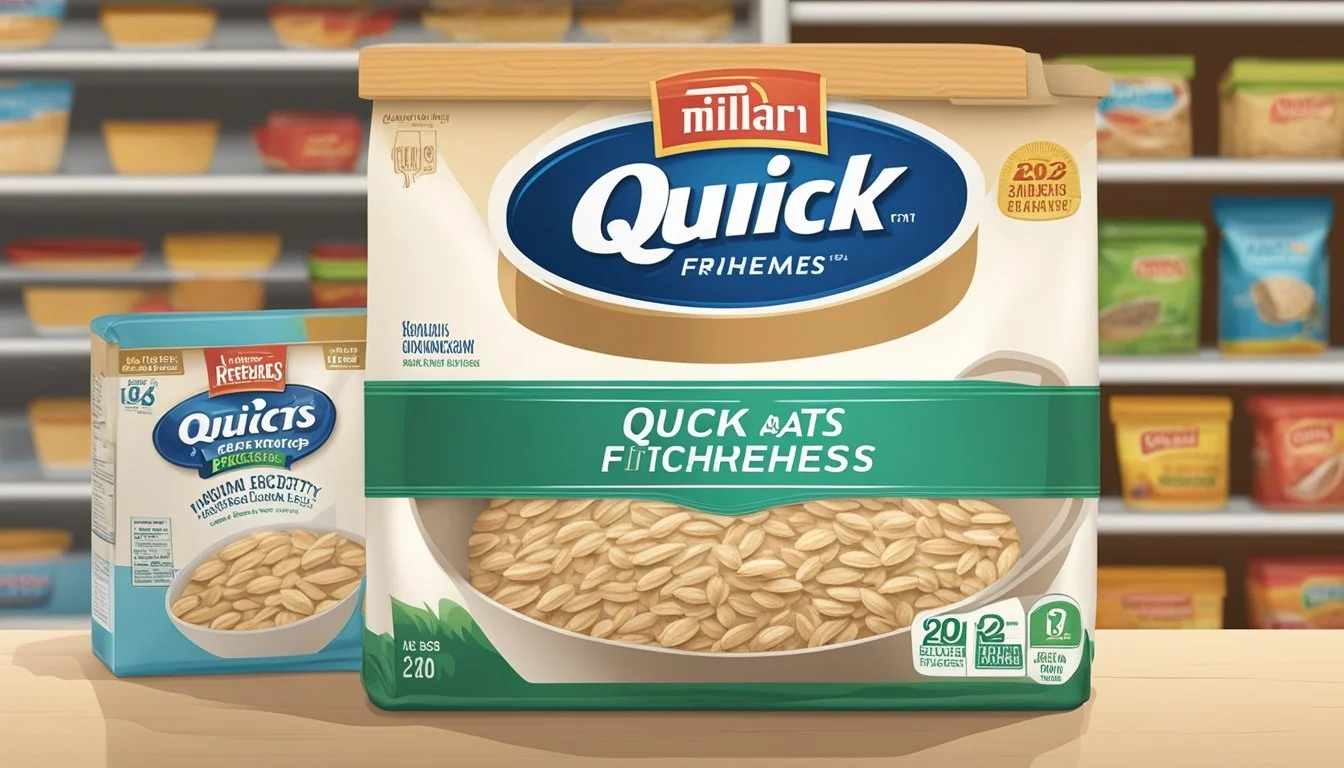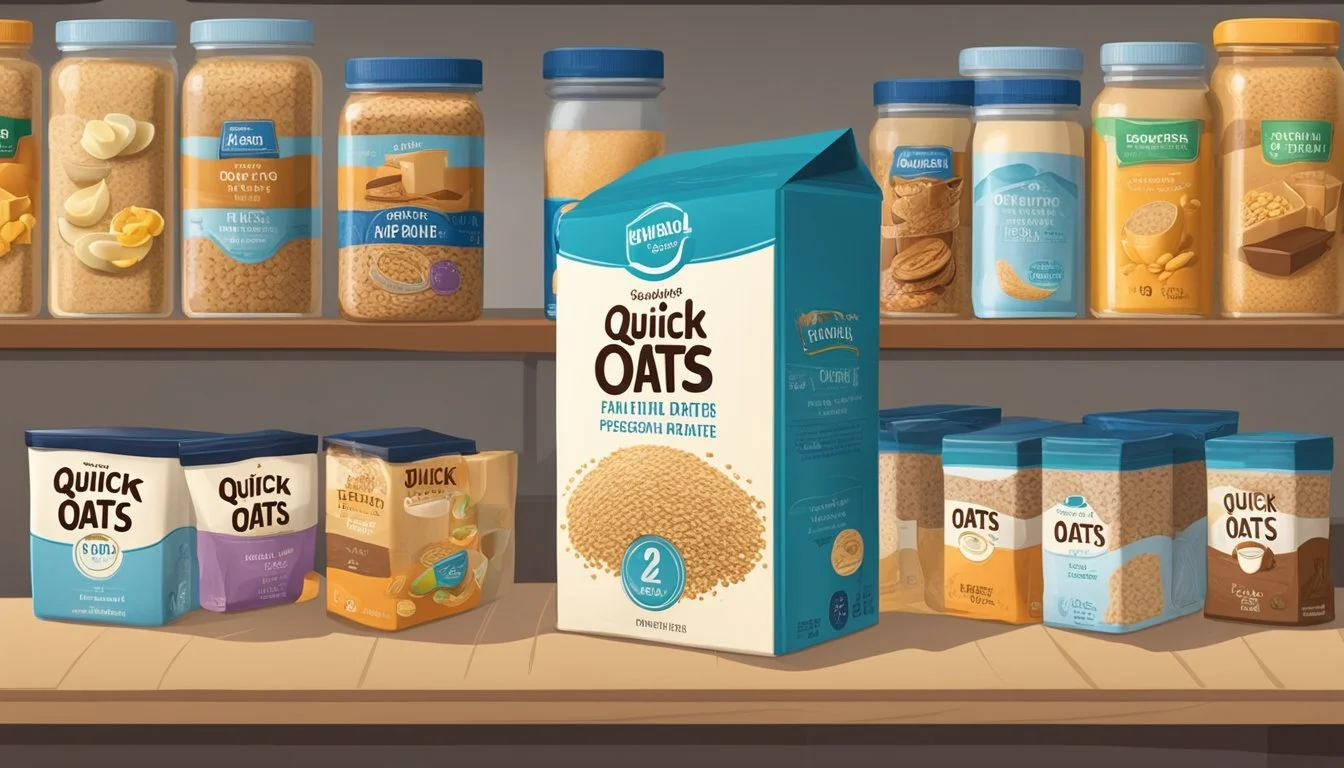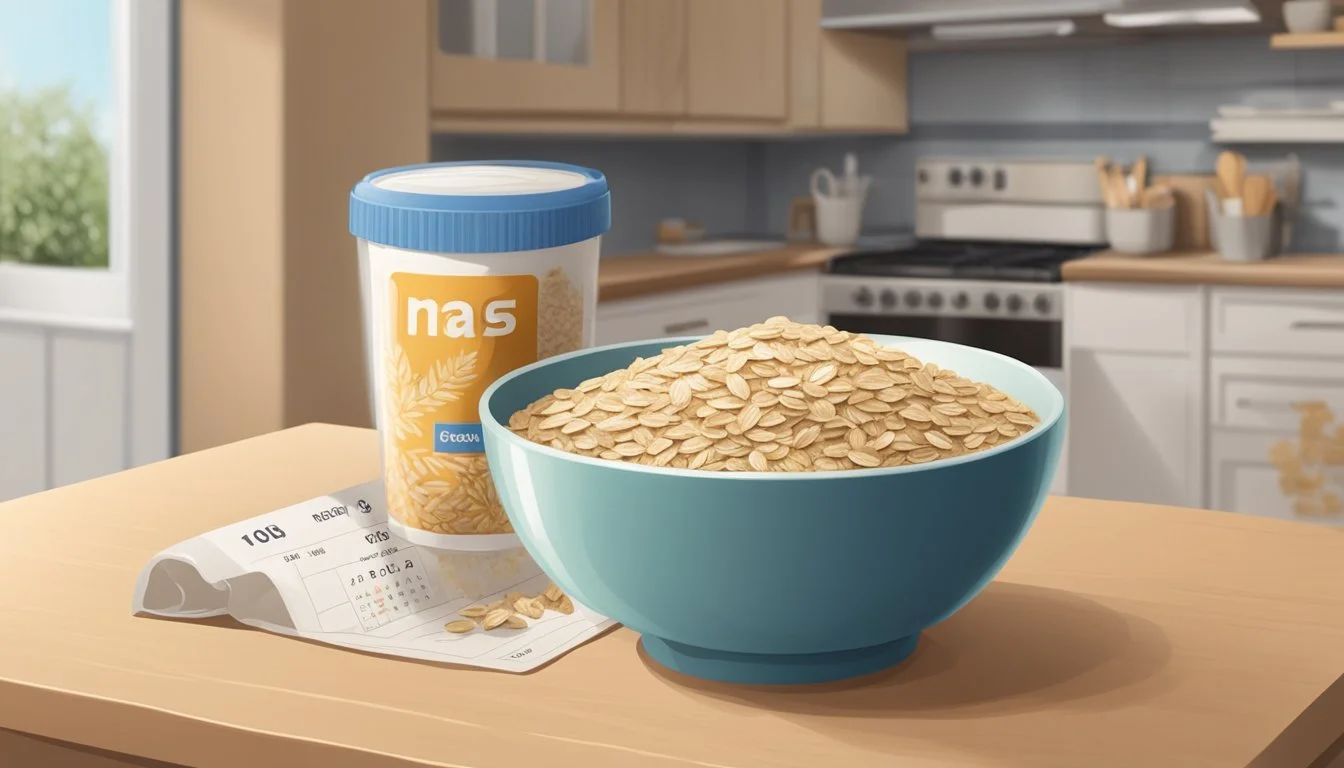How Long Do Quick Oats Last?
Shelf Life and Storage Tips
Quick oats are a convenient and healthy staple in many households, providing a quick and nutritious start to the day. Understanding the shelf life of quick oats is important for both food safety and quality. Typically, unopened packages of quick oats can last well beyond the printed expiration date, retaining freshness for up to two years when stored in a cool, dry place. Once opened, the oats should be kept in an airtight container to maintain their quality and extend their usability.
It is pivotal to recognize the signs that indicate when quick oats may no longer be good to consume. A change in color, odor, or the presence of mold suggests that the oats have gone bad and should be discarded. Additionally, pantry pests can compromise the quality of quick oats; hence, proper storage is crucial to prevent infestation and spoilage.
While quick oats have a considerable shelf life, it is essential to handle them correctly to ensure they remain a safe and enjoyable part of the diet. Regularly checking the oats for any signs of spoilage is recommended, especially if the oats are nearing or have passed the best-by date. They can be a wholesome food choice over time with proper storage and attention to changes in their condition.
Understanding Quick Oats
Quick oats are a convenient option within the range of oat products available, offering a fast cooking time while preserving the nutritious value associated with oats. They are a subtype of rolled oats (how long do rolled oats last?) that have been further processed to decrease cooking time.
Types of Oats
Whole Oat Groats: Unprocessed kernels, long cooking time.
Steel Cut Oats: Groats cut into pieces, nuttier flavor, longer cooking time.
Rolled Oats: Groats steamed and rolled flat, shorter cooking time than steel cut oats.
Quick Oats: Rolled oats that are cut into smaller pieces and rolled thinner to cook quickly.
Instant Oats: Finely chopped and pre-cooked, fastest cooking time.
Quick oats, being one iteration of rolled oats, are distinguished by their processing methods and resulting cooking time. They fit into the spectrum of oat varieties that include whole oat groats at one end (least processed) and instant oats at the other (most processed).
Nutritional Value
Nutrient Benefit Dietary Fiber Supports digestive health Proteins Vital for tissue repair and growth Vitamins Includes B vitamins for energy metabolism Minerals Iron, magnesium for various body functions
Quick oats maintain a similar nutritional profile to other types of oats, providing essential fiber, vitamins, and minerals. They offer a rich source of soluble fiber, which is beneficial for heart health and blood sugar control. The processing of quick oats does not significantly diminish their nutrient content.
Shelf Life Determinants
When considering the shelf life of quick oats, two pivotal factors come into play: the effectiveness of the packaging and the environmental conditions in which the oats are stored. These determinants can significantly affect the longevity and freshness of quick oats.
Packaging Influence
The packaging of quick oats is crucial for preserving their freshness and extending their shelf life. Oats are commonly packaged in materials that protect against moisture and oxygen, two elements that can degrade the quality of the oats. When quick oats are sealed in airtight containers, this barrier limits exposure to environmental factors that can accelerate spoilage. Manufacturers often use packaging that includes protective layers to prevent the infiltration of light and moisture, ensuring the oats remain dry and less susceptible to oxidation and other spoilage processes.
Environmental Factors
Environmental factors such as temperature change and exposure to light can dramatically impact the shelf life of quick oats. Consistent storage in a cool, dry place away from direct sunlight helps preserve their quality. Moisture is a key enemy of quick oats, as it can lead to mold growth and spoilage. A storage area that is too warm or fluctuates in temperature can induce moisture buildup, even in airtight containers. By controlling these environmental factors, consumers can greatly extend the shelf life of their quick oats.
Signs of Spoilage
Quick oats can last a long time, but they are not immune to spoilage. Recognizing the early signs of spoilage can prevent foodborne illness and ensure that oats are consumed when they are at their best quality.
Changes in Texture and Flavor
One can detect spoilage in quick oats through changes in texture and flavor. If the oats have absorbed moisture, they may become unusually clumpy, slimy, or sticky, which is not their typical dry and loose state. Flavor changes are also indicative of spoilage; if the oats taste stale or have an unpleasant bitterness, they should not be consumed.
Visible Mold and Discoloration
Visual inspection is vital for detecting spoilage. Mold growth, which can appear as fuzzy spots of green, white, or black, is a clear sign that quick oats have gone bad. Discoloration in oats, such as any dark or unnatural spots that were not present when first purchased, indicates deterioration.
Off-Putting Smell
A reliable indicator of spoiled quick oats is an off-putting smell. Fresh quick oats should have a mild, slightly nutty aroma. If one notices a musty, sour, or otherwise funky scent, the oats have likely spoiled and should be discarded to avoid the consumption of potentially harmful microbes.
Proper Storage Methods
When storing quick oats, their longevity and freshness hinge substantially on maintaining ideal storage conditions and utilizing suitable containers for preservation.
Ideal Storage Conditions
Quick oats are best kept in a cool, dry environment, such as a pantry, to prolong their shelf life. The optimal temperature for storage is below 70°F (21°C), with relative humidity under 65% to prevent the intrusion of moisture that can lead to spoilage. Inappropriate storage conditions can result in a noticeable degradation of flavor and texture over time.
Best Containers for Preservation
The choice of storage container is pivotal in preserving the quality of quick oats.
Airtight Containers: These are essential in preventing exposure to moisture and pests. Common materials for airtight containers include glass, stainless steel, or ceramic. A tightly sealed lid is crucial.
#10 Cans and Mylar Bags: For long-term storage, #10 cans — large, commercially sealed cans — and mylar bags with oxygen absorbers can extend the shelf life of quick oats significantly.
Refrigeration: Although not necessary for short-term storage, placing quick oats in an airtight container in the fridge can further extend their freshness.
By adhering to these storage recommendations, quick oats can remain a wholesome staple in one's diet for an extended period.
Maximizing Freshness and Safety
To ensure the longevity and safety of both uncooked and cooked oats, appropriate handling and storage are essential. Adhering strictly to best practices significantly reduces the risk of foodborne illness and maintains freshness.
Handling Uncooked Oats
Uncooked oats, including quick oats, should always be stored in a cool, dry place away from direct sunlight. Exposure to heat, moisture, or strong odors can degrade the quality of the oats and potentially lead to the development of harmful bacteria. After opening the original packaging, it is advisable to transfer the oats to an airtight container. This not only preserves their freshness but also prevents contamination from pests or other environmental factors. As a guideline, uncooked oats have a shelf life that typically exceeds the expiration date by several months if they remain sealed. However, once opened and properly stored, they can still maintain quality for up to 12 months.
Tips for Handling Uncooked Oats:
Store in a cool, dry place.
After opening, transfer to an airtight container.
Keep away from strong odors to prevent the oats from absorbing them.
Storing Cooked Oatmeal
Once oatmeal is cooked, its shelf life is considerably shorter. Cooked oatmeal should be stored in the refrigerator within two hours of cooking to minimize the risk of bacterial growth that could lead to foodborne illness. It would be best if you stored it in a covered airtight container to maintain its freshness and prevent it from absorbing any odors present in the refrigerator. Generally, cooked oatmeal is safe to eat for up to 5 days when properly refrigerated. Freezing cooked oatmeal is an option as well and can extend its edible period. It's important to note that signs of spoilage include off odor, flavor, or appearance. Eating spoiled oatmeal carries health risks and should be avoided.
Guidelines for Storing Cooked Oatmeal:
Refrigerate within two hours of cooking.
Store in a covered airtight container to maintain freshness.
Consume within 5 days to avoid potential health risks.
Beyond the Pantry
When quick oats surpass their shelf life, they can still prove useful beyond culinary applications. This section explores the versatility of oats that are past their prime.
Creative Uses of Expired Oats
Expired oats need not go to waste; they have a place in household and gardening activities. Although the nutritional value is diminished, they can serve as a thickener in recipes such as meatloaf or homemade dog treats. For gardeners, expired oats can be scattered as a natural fertilizer or mixed into compost to add a carbon-rich element.
Oatmeal in Beauty and Health
Even beyond their consumption date, oats retain qualities beneficial for beauty and health treatments. Oatmeal's soothing properties make it an excellent choice for a nourishing bath additive. An oatmeal bath can calm irritated skin and may contribute to reducing inflammation. In skincare, ground oats are often incorporated into face masks to gently exfoliate and absorb excess oil. While these uses do not capitalize on the potential to lower cholesterol, they leverage the inherent soothing and absorptive properties of the oats.
Understanding Expiration Labels
When purchasing quick oats, consumers often see date labels such as "best by date" and "expiration date" on packaging. Recognizing the difference between these terms is crucial for proper oatmeal storage and consumption.
Best By Date Versus Expiration Date
Best by Date: Indicates the time frame during which the quick oats are expected to retain optimal quality and flavor. It is not a safety-related deadline but rather the manufacturer's estimate of how long the product will remain at peak quality.
The "best by" label is highly relevant for items like quick oats, as freshness can impact taste.
Expiration Date: Serves as a more definitive guideline for certain food items that are critical for consumer health, suggesting when the product should no longer be consumed.
Quick oats may not carry a strict "expiration date" since they are less perishable; rather, they often feature a "best by" date.
It is important to note that quick oats can remain safe to consume even after the "best by" date, assuming they have been stored properly. However, their quality in terms of taste and texture may decline. Consumers should always inspect the oats for signs of spoilage such as mold or off-smells, regardless of the printed dates.
When to Dispose of Oats
Determining when oats are no longer safe to consume is crucial to maintaining food safety. The shelf life of quick oats can be impacted by several factors that may lead them to become unsafe to consume.
Safety Considerations After Expiration
After the expiration date, quick oats may become unsafe and should be examined carefully before consumption. Food poisoning can result from consuming expired oats that have become contaminated with bacteria or molds. If oats have a stale or rancid odor, a change in texture, or visible signs of mold, they should not be consumed. It is essential to check quick oats for these spoilage indicators, especially if they've been stored beyond their expiration date.
Smell: A sour or musty scent is a key indicator of rancid oats.
Texture: Oats that have become unusually hard or moist may indicate spoilage.
Visual Inspection: Presence of mold or a significant change in color could signify that oats are no longer safe to eat.
Storing oats in a cool, dry place and in an airtight container can help extend their shelf life. However, even with proper storage, oats can still become unsafe to eat. It's always better to err on the side of caution and dispose of any oats that one suspects to be possibly unsafe.
FAQs in Oatmeal Storage
When storing oatmeal, understanding the balance between shelf life and food safety is crucial. Different storage methods can significantly affect the longevity of oats.
Can Oats Be Frozen for Longevity?
Yes, oats can be frozen to extend their shelf life. Quick oats stored in the freezer remain safe to eat for an extended period, typically up to 24 months. It's essential to store them in airtight containers or freezer bags to prevent moisture accumulation, which could lead to spoilage. Freezing does not affect the nutritional value of oats, and they require no thawing before use – oats can be added directly to the cooking process, such as steaming or boiling.
How to Identify Rancid Oats?
Oats that have gone rancid will develop an off-putting smell and might have a noticeable change in color or texture. If oats smell musty, sour, or have a noticeable change in flavor, they are no longer safe to eat. Rancidity occurs due to the natural fats in oats breaking down, which happens faster when oats are exposed to heat, light, or moisture. This can be accelerated if the oats are not stored properly, such as leaving them in a warm, humid environment instead of in refrigeration or a cool, dry place.









